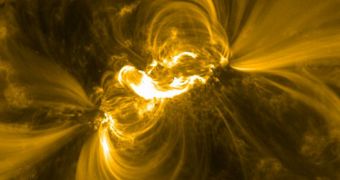Solar physicists at the American space agency report that one of their solar monitoring spacecraft has picked up what appears to be the largest, most significant solar flare of the current Sun cycle.
Our star usually functions in 11-year cycles, during which periods of intense solar activity alternate with periods of relative tranquility. When the Sun is most active, the period is called a solar maximum.
It is characterized by large number of solar flares and sunspots developing on the star's surface. When the solar minimum ensues, activity drops to basal levels, and only very small numbers of events are recorded by dedicated spacecraft.
At this time, we are heading towards the peak of the solar maximum, which is bound to occur sometime in 2012 or 2013. As such, we are witnessing an increase in solar activity, including larger numbers of solar flares.
On February 13, experts recorded the largest solar flare that occurred during the current cycle, and they named the event sunspot 1158. The team in charge of the study says that instruments following the Sun's activity lit up in all wavelengths.
The huge explosion emitted vast amounts of radiation across the electromagnetic spectrum, all the way from radio waves to X-rays and gamma rays, Universe Today reports.
One NASA telescope even recorded an intense flash of extreme ultraviolet radiation (EUV). The Solar Dynamics Observatory (SDO), part of the space agency's “Living with a Star” program, is uniquely equipped to conduct investigations in EUV wavelengths.
The Solar Terrestrial Relations Observatory-A (STEREO) spacecraft also observed the solar event with its coronagraph, an instrument that looks at activity recorded up in the Sun's atmosphere.
Interestingly, the coronal mass ejection that followed the event was not particularly bright, data from STEREO-A and the Solar and Heliospheric Observatory (SOHO) show. SOHO is jointly operated by NASA and the European Space Agency (ESA).
But the eruption compensated for the lack of brightness through an incredibly loud blast of radio waves, which was “heard” by all ground-based radio telescopes that were facing the Sun.
It is estimated that the material the coronal mass ejection threw into the Sun's surroundings will reach Earth today, February 15. As a result, aurora lights may be especially bright today and tomorrow.

 14 DAY TRIAL //
14 DAY TRIAL //